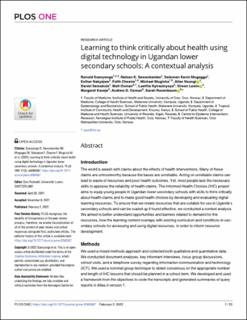| dc.contributor.author | Ssenyonga, Ronald | |
| dc.contributor.author | Sewankambo, Nelson K. | |
| dc.contributor.author | Mugagga, Solomon Kevin | |
| dc.contributor.author | Nakyejwe, Esther | |
| dc.contributor.author | Chesire, Faith | |
| dc.contributor.author | Mugisha, Michael | |
| dc.contributor.author | Nsangi, Allen | |
| dc.contributor.author | Semakula, Daniel | |
| dc.contributor.author | Oxman, Matt | |
| dc.contributor.author | Nyirazinyoye, Laetitia | |
| dc.contributor.author | Lewin, Simon | |
| dc.contributor.author | Kaseje, Margaret | |
| dc.contributor.author | Oxman, Andrew David | |
| dc.contributor.author | Rosenbaum, Sarah Ellen | |
| dc.coverage.spatial | Uganda | en_US |
| dc.date.accessioned | 2022-05-03T06:21:31Z | |
| dc.date.available | 2022-05-03T06:21:31Z | |
| dc.date.created | 2022-04-26T10:46:24Z | |
| dc.date.issued | 2022-02-02 | |
| dc.identifier.citation | PLOS ONE. 2022, 17 (2), 1-22. | en_US |
| dc.identifier.issn | 1932-6203 | |
| dc.identifier.uri | https://hdl.handle.net/11250/2993741 | |
| dc.description.abstract | Introduction: The world is awash with claims about the effects of health interventions. Many of these claims are untrustworthy because the bases are unreliable. Acting on unreliable claims can lead to waste of resources and poor health outcomes. Yet, most people lack the necessary skills to appraise the reliability of health claims. The Informed Health Choices (IHC) project aims to equip young people in Ugandan lower secondary schools with skills to think critically about health claims and to make good health choices by developing and evaluating digital learning resources. To ensure that we create resources that are suitable for use in Uganda’s secondary schools and can be scaled up if found effective, we conducted a context analysis. We aimed to better understand opportunities and barriers related to demand for the resources, how the learning content overlaps with existing curriculum and conditions in secondary schools for accessing and using digital resources, in order to inform resource development.
Methods: We used a mixed methods approach and collected both qualitative and quantitative data. We conducted document analyses, key informant interviews, focus group discussions, school visits, and a telephone survey regarding information communication and technology (ICT). We used a nominal group technique to obtain consensus on the appropriate number and length of IHC lessons that should be planned in a school term. We developed and used a framework from the objectives to code the transcripts and generated summaries of query reports in Atlas.ti version 7.
Findings: Critical thinking is a key competency in the lower secondary school curriculum. However, the curriculum does not explicitly make provision to teach critical thinking about health, despite a need acknowledged by curriculum developers, teachers and students. Exam oriented teaching and a lack of learning resources are additional important barriers to teaching critical thinking about health. School closures and the subsequent introduction of online learning during the COVID-19 pandemic has accelerated teachers’ use of digital equipment and learning resources for teaching. Although the government is committed to improving access to ICT in schools and teachers are open to using ICT, access to digital equipment, unreliable power and internet connections remain important hinderances to use of digital learning resources.
Conclusions: There is a recognized need for learning resources to teach critical thinking about health in Ugandan lower secondary schools. Digital learning resources should be designed to be usable even in schools with limited access and equipment. Teacher training on use of ICT for teaching is needed. | en_US |
| dc.language.iso | eng | en_US |
| dc.publisher | Public Library of Science | en_US |
| dc.relation.ispartofseries | PLOS ONE;2022, 17 (2) | |
| dc.rights | Navngivelse 4.0 Internasjonal | * |
| dc.rights.uri | http://creativecommons.org/licenses/by/4.0/deed.no | * |
| dc.subject | Health literacy | en_US |
| dc.subject | Informed health Choices (IHC) | en_US |
| dc.subject | Adolescent pupils | en_US |
| dc.subject | Digital learning resources | en_US |
| dc.subject | Education | en_US |
| dc.title | Learning to think critically about health using digital technology in Ugandan lower secondary schools: A contextual analysis | en_US |
| dc.type | Peer reviewed | en_US |
| dc.type | Journal article | en_US |
| dc.description.version | publishedVersion | en_US |
| dc.rights.holder | © 2022 Ssenyonga et al. | en_US |
| cristin.ispublished | true | |
| cristin.fulltext | original | |
| cristin.qualitycode | 1 | |
| dc.identifier.doi | 10.1371/journal.pone.0260367 | |
| dc.identifier.cristin | 2019140 | |
| dc.source.journal | PLOS ONE | en_US |
| dc.source.volume | 17 | en_US |
| dc.source.issue | 2 | en_US |
| dc.source.pagenumber | 1-22 | en_US |
| dc.relation.project | Norges forskningsråd: 284683 | en_US |

